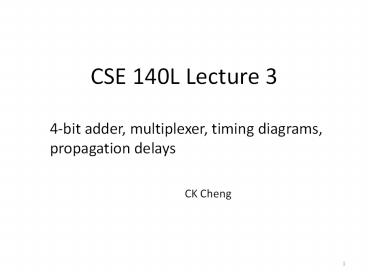CSE%20140L%20Lecture%203 - PowerPoint PPT Presentation
Title:
CSE%20140L%20Lecture%203
Description:
CSE 140L Lecture 3 4-bit adder, multiplexer, timing diagrams, propagation delays CK Cheng * Timing behavior Real circuits have delays Gate delay time for an ... – PowerPoint PPT presentation
Number of Views:98
Avg rating:3.0/5.0
Title: CSE%20140L%20Lecture%203
1
CSE 140L Lecture 3
- 4-bit adder, multiplexer, timing diagrams,
propagation delays
CK Cheng
2
Timing behavior
- Real circuits have delays
- Gate delay time for an output of the gate to
change after its input changes - We can simulate timing delays in Quartus II to
see these delays
3
Gate delay
- Notice rise time, fall time, and gate delay
input
output
input
output
4
Quartus II Timing Simulation
Notice the glitches and delay in the output
5
4-bit Ripple Carry Adders
- Chain 4 1-bit full adders together. Connect the
carry-out of the previous adder and the carry-in
of the next adder. - Worst delay path (critical path) from A0, B0, or
C0 to S3, or C4
6
Critical Path for worst delay
- Propagation from C0 to C4
- C4 changes as C0 toggles
C0
1110 0001
C4
7
Multiplexers
-Multiplexers (MUXes) are like selectors. There
is one output, 2 or more inputs, and a selector
input that determines which of those inputs gets
outputed. -Allows several devices to share one
single line.
This is a 21 mux. It has 2 inputs, 1 output.
Because there are only 2 inputs, S is one bit. If
S0, then we output A. If S1, then we output B.
A
MUX
Z
B
S
8
Multiplexers
-The truth table for the 1-bit 21 MUX.
When S0, the MUX will select A as its output. It
doesnt matter what B is. Likewise, When S1, B
is selected as output.
S A B Z
0 1 1 1
0 1 0 1
0 0 1 0
0 0 0 0
1 1 1 1
1 1 0 0
1 0 1 1
1 0 0 0
The boolean equation Z AS BS
9
Multiplexers
-If S is 0, then I0 will pass and I1 is blocked.
Thus, yI0. -Likewise, if S is 1, yI1.
10
Multiplexers
-We can also make a 41 MUX using three 21 MUX
If S1S0 00, then S1 will select MUX from A and
B. Since S00, Z A.
A
0
MUX
1
B
0
Z
MUX
S0
Z
1
C
0
MUX
S1
D
1
11
Multiplexers
-We can make 41 and above MUXes too. -With 4
inputs, our selector needs to have two bits.
12
Exercises
Subtractors a. Subtraction b. Ones
Complement c. Twos Complement































